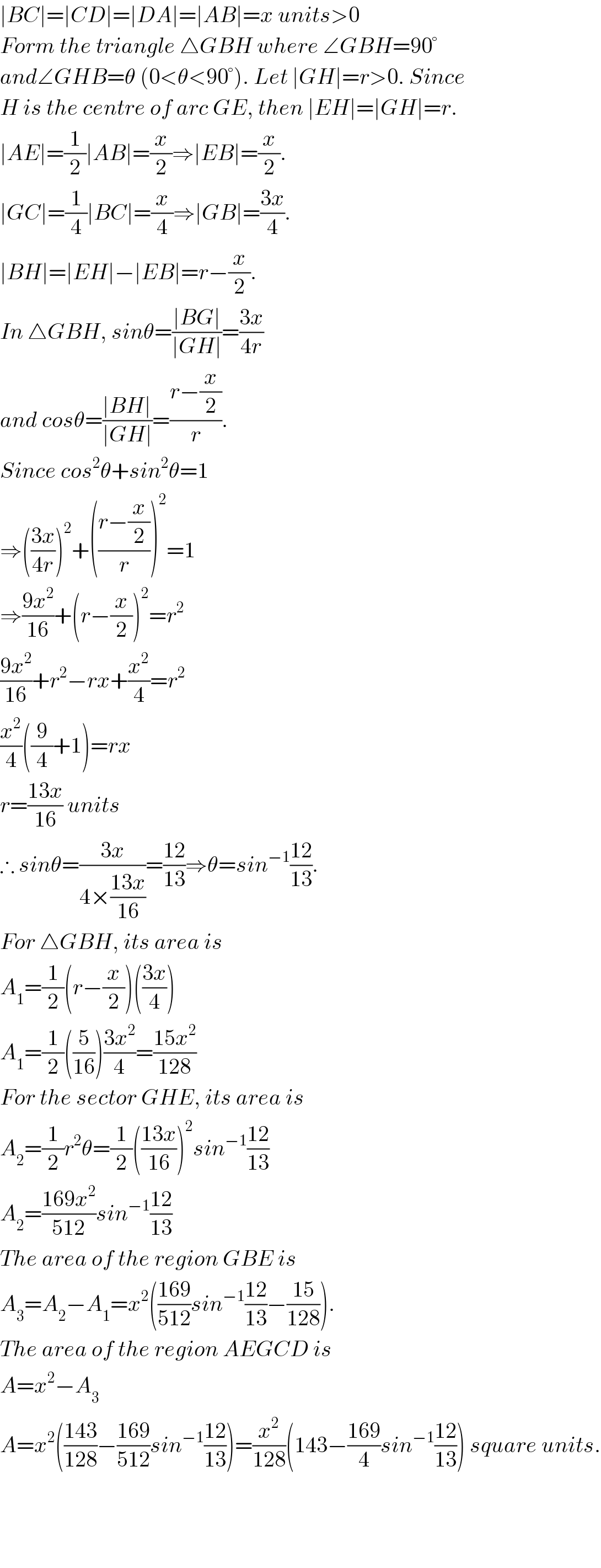
Question Number 6157 by Rasheed Soomro last updated on 16/Jun/16

Answered by Yozzii last updated on 16/Jun/16

$$\mid{BC}\mid=\mid{CD}\mid=\mid{DA}\mid=\mid{AB}\mid={x}\:{units}>\mathrm{0} \\ $$$${Form}\:{the}\:{triangle}\:\bigtriangleup{GBH}\:{where}\:\angle{GBH}=\mathrm{90}° \\ $$$${and}\angle{GHB}=\theta\:\left(\mathrm{0}<\theta<\mathrm{90}°\right).\:{Let}\:\mid{GH}\mid={r}>\mathrm{0}.\:{Since} \\ $$$${H}\:{is}\:{the}\:{centre}\:{of}\:{arc}\:{GE},\:{then}\:\mid{EH}\mid=\mid{GH}\mid={r}. \\ $$$$\mid{AE}\mid=\frac{\mathrm{1}}{\mathrm{2}}\mid{AB}\mid=\frac{{x}}{\mathrm{2}}\Rightarrow\mid{EB}\mid=\frac{{x}}{\mathrm{2}}. \\ $$$$\mid{GC}\mid=\frac{\mathrm{1}}{\mathrm{4}}\mid{BC}\mid=\frac{{x}}{\mathrm{4}}\Rightarrow\mid{GB}\mid=\frac{\mathrm{3}{x}}{\mathrm{4}}. \\ $$$$\mid{BH}\mid=\mid{EH}\mid−\mid{EB}\mid={r}−\frac{{x}}{\mathrm{2}}. \\ $$$${In}\:\bigtriangleup{GBH},\:{sin}\theta=\frac{\mid{BG}\mid}{\mid{GH}\mid}=\frac{\mathrm{3}{x}}{\mathrm{4}{r}} \\ $$$${and}\:{cos}\theta=\frac{\mid{BH}\mid}{\mid{GH}\mid}=\frac{{r}−\frac{{x}}{\mathrm{2}}}{{r}}. \\ $$$${Since}\:{cos}^{\mathrm{2}} \theta+{sin}^{\mathrm{2}} \theta=\mathrm{1} \\ $$$$\Rightarrow\left(\frac{\mathrm{3}{x}}{\mathrm{4}{r}}\right)^{\mathrm{2}} +\left(\frac{{r}−\frac{{x}}{\mathrm{2}}}{{r}}\right)^{\mathrm{2}} =\mathrm{1} \\ $$$$\Rightarrow\frac{\mathrm{9}{x}^{\mathrm{2}} }{\mathrm{16}}+\left({r}−\frac{{x}}{\mathrm{2}}\right)^{\mathrm{2}} ={r}^{\mathrm{2}} \\ $$$$\frac{\mathrm{9}{x}^{\mathrm{2}} }{\mathrm{16}}+{r}^{\mathrm{2}} −{rx}+\frac{{x}^{\mathrm{2}} }{\mathrm{4}}={r}^{\mathrm{2}} \\ $$$$\frac{{x}^{\mathrm{2}} }{\mathrm{4}}\left(\frac{\mathrm{9}}{\mathrm{4}}+\mathrm{1}\right)={rx} \\ $$$${r}=\frac{\mathrm{13}{x}}{\mathrm{16}}\:{units} \\ $$$$\therefore\:{sin}\theta=\frac{\mathrm{3}{x}}{\mathrm{4}×\frac{\mathrm{13}{x}}{\mathrm{16}}}=\frac{\mathrm{12}}{\mathrm{13}}\Rightarrow\theta={sin}^{−\mathrm{1}} \frac{\mathrm{12}}{\mathrm{13}}. \\ $$$${For}\:\bigtriangleup{GBH},\:{its}\:{area}\:{is}\: \\ $$$${A}_{\mathrm{1}} =\frac{\mathrm{1}}{\mathrm{2}}\left({r}−\frac{{x}}{\mathrm{2}}\right)\left(\frac{\mathrm{3}{x}}{\mathrm{4}}\right) \\ $$$${A}_{\mathrm{1}} =\frac{\mathrm{1}}{\mathrm{2}}\left(\frac{\mathrm{5}}{\mathrm{16}}\right)\frac{\mathrm{3}{x}^{\mathrm{2}} }{\mathrm{4}}=\frac{\mathrm{15}{x}^{\mathrm{2}} }{\mathrm{128}} \\ $$$${For}\:{the}\:{sector}\:{GHE},\:{its}\:{area}\:{is}\: \\ $$$${A}_{\mathrm{2}} =\frac{\mathrm{1}}{\mathrm{2}}{r}^{\mathrm{2}} \theta=\frac{\mathrm{1}}{\mathrm{2}}\left(\frac{\mathrm{13}{x}}{\mathrm{16}}\right)^{\mathrm{2}} {sin}^{−\mathrm{1}} \frac{\mathrm{12}}{\mathrm{13}} \\ $$$${A}_{\mathrm{2}} =\frac{\mathrm{169}{x}^{\mathrm{2}} }{\mathrm{512}}{sin}^{−\mathrm{1}} \frac{\mathrm{12}}{\mathrm{13}} \\ $$$${The}\:{area}\:{of}\:{the}\:{region}\:{GBE}\:{is} \\ $$$${A}_{\mathrm{3}} ={A}_{\mathrm{2}} −{A}_{\mathrm{1}} ={x}^{\mathrm{2}} \left(\frac{\mathrm{169}}{\mathrm{512}}{sin}^{−\mathrm{1}} \frac{\mathrm{12}}{\mathrm{13}}−\frac{\mathrm{15}}{\mathrm{128}}\right). \\ $$$${The}\:{area}\:{of}\:{the}\:{region}\:{AEGCD}\:{is} \\ $$$${A}={x}^{\mathrm{2}} −{A}_{\mathrm{3}} \\ $$$${A}={x}^{\mathrm{2}} \left(\frac{\mathrm{143}}{\mathrm{128}}−\frac{\mathrm{169}}{\mathrm{512}}{sin}^{−\mathrm{1}} \frac{\mathrm{12}}{\mathrm{13}}\right)=\frac{{x}^{\mathrm{2}} }{\mathrm{128}}\left(\mathrm{143}−\frac{\mathrm{169}}{\mathrm{4}}{sin}^{−\mathrm{1}} \frac{\mathrm{12}}{\mathrm{13}}\right)\:{square}\:{units}. \\ $$$$ \\ $$$$ \\ $$$$ \\ $$
Commented by Rasheed Soomro last updated on 16/Jun/16

$$\mathfrak{NICE}! \\ $$$$\mathfrak{THANKS}!\:{Although}\:{I}\:{thought}\:{a} \\ $$$${different}\:{approach},\:{like}\:{your} \\ $$$${approach}\:{too}.{My}\:{approach}\:{needs} \\ $$$${some}\:{construction}\:{lines}. \\ $$$${So}\:{I}\:{think}\:{your}\:{approach}\:{is}\:{better}! \\ $$
Commented by Yozzii last updated on 16/Jun/16

$${I}\:{see}.\:{I}\:{think}\:{you}\:{should}\:{still} \\ $$$${share}\:{your}\:{method},\:{just}\:{to} \\ $$$${give}\:{an}\:{alternative}\:{approach}. \\ $$
Commented by Rasheed Soomro last updated on 17/Jun/16

$${Not}\:{my}\:{entire}\:{method}\:{is}\:{different}.\:{Only}\:{difference} \\ $$$${is}\:{in}\:{computing}\:{radius}\:{and}\:{angle}\:{of}\:{the}\:{sector}.... \\ $$
Commented by Yozzii last updated on 17/Jun/16

$${Ah}\:{ok}\:{lol}.\: \\ $$
Commented by Rasheed Soomro last updated on 17/Jun/16

Commented by Rasheed Soomro last updated on 18/Jun/16
![The radius and angle of the sector can also be determined in the following way: Construction:Join E and G.Draw perpendicular-bisector of EG. Also join G and H According to Yozzi′s answer ∣EB∣=(1/2)x and ∣BG∣=(3/4)x •So in△EBG, ∣EG∣=(√((x/2)^2 +(3x/4)^2 )) =(√((x^2 /4)+((9x^2 )/(16))))=((√(13))/4)x So, ∣EJ∣=(1/2)∣EG∣=(1/2)(((√(13))/4)x)=((√(13))/8)x [HJ^(↔) is perpendicular bisector] Let ∠GEB=α, cos α=∣EB∣/∣EG∣=((1/2)x)/(((√(13))/4)x)=(2/(√(13))) α=cos^(−1) (2/(√(13))) •Now in △EJH, ∣EJ∣=((√(13))/8)x and α=cos^(−1) (2/(√(13))) cos α=∣EJ∣/∣EH∣ cos (cos^(−1) (2/(√(13))))=((((√(13))/8)x)/r) [let ∣EH∣=r] (2/(√(13)))=(((√(13))x)/(8r)) 16r=13x r=((13)/(16))x Let ∠JHE=β and ∠GHE=θ β=90°−α=90°−cos^(−1) (2/(√(13))) θ=2β=180°−2cos^(−1) (2/(√(13))) For further simplification see YOZZII ′s answer to Q#6183. According to it θ=sin^(−1) (((12)/(13)))](Q6176.png)
$${The}\:{radius}\:{and}\:{angle}\:{of}\:{the}\:{sector} \\ $$$${can}\:{also}\:{be}\:{determined}\:{in}\:{the}\:{following} \\ $$$${way}: \\ $$$${Construction}:{Join}\:{E}\:{and}\:{G}.{Draw}\: \\ $$$${perpendicular}-{bisector}\:{of}\:{EG}. \\ $$$${Also}\:{join}\:{G}\:{and}\:{H} \\ $$$${According}\:{to}\:{Yozzi}'{s}\:{answer} \\ $$$$\:\:\:\:\:\:\:\:\mid{EB}\mid=\frac{\mathrm{1}}{\mathrm{2}}{x}\:\:{and}\:\:\:\mid{BG}\mid=\frac{\mathrm{3}}{\mathrm{4}}{x} \\ $$$$\bullet{So}\:{in}\bigtriangleup{EBG},\:\:\mid{EG}\mid=\sqrt{\left({x}/\mathrm{2}\right)^{\mathrm{2}} +\left(\mathrm{3}{x}/\mathrm{4}\right)^{\mathrm{2}} } \\ $$$$\:\:\:\:\:\:\:\:\:\:\:\:\:\:\:\:\:\:\:\:\:\:\:\:\:\:\:\:\:\:\:\:\:\:\:\:\:\:\:\:\:\:=\sqrt{\frac{{x}^{\mathrm{2}} }{\mathrm{4}}+\frac{\mathrm{9}{x}^{\mathrm{2}} }{\mathrm{16}}}=\frac{\sqrt{\mathrm{13}}}{\mathrm{4}}{x} \\ $$$$\:{So},\:\:\mid{EJ}\mid=\frac{\mathrm{1}}{\mathrm{2}}\mid{EG}\mid=\frac{\mathrm{1}}{\mathrm{2}}\left(\frac{\sqrt{\mathrm{13}}}{\mathrm{4}}{x}\right)=\frac{\sqrt{\mathrm{13}}}{\mathrm{8}}{x}\:\left[\overset{\leftrightarrow} {{HJ}}\:{is}\:{perpendicular}\:{bisector}\right] \\ $$$${Let}\:\:\angle{GEB}=\alpha,\:\:\:\mathrm{cos}\:\:\alpha=\mid{EB}\mid/\mid{EG}\mid=\left(\frac{\mathrm{1}}{\mathrm{2}}{x}\right)/\left(\frac{\sqrt{\mathrm{13}}}{\mathrm{4}}{x}\right)=\frac{\mathrm{2}}{\sqrt{\mathrm{13}}} \\ $$$$\:\:\:\:\:\:\:\:\:\:\:\:\:\:\:\:\:\:\:\:\:\:\:\:\:\:\:\:\:\:\:\:\:\:\:\:\:\alpha=\mathrm{cos}^{−\mathrm{1}} \:\frac{\mathrm{2}}{\sqrt{\mathrm{13}}}\: \\ $$$$ \\ $$$$\bullet{Now}\:{in}\:\bigtriangleup{EJH},\:\:\mid{EJ}\mid=\frac{\sqrt{\mathrm{13}}}{\mathrm{8}}{x}\:\:\:{and}\:\:\alpha=\mathrm{cos}^{−\mathrm{1}} \:\frac{\mathrm{2}}{\sqrt{\mathrm{13}}}\: \\ $$$$\:\:\:\:\:\:\:\:\:\:\:\:\:\:\:\:\:\:\:\:\:\:\:\:\:\:\:\:\:\:\:\:\:\:\:\mathrm{cos}\:\alpha=\mid{EJ}\mid/\mid{EH}\mid \\ $$$$\:\:\:\:\:\:\:\:\:\:\:\:\:\:\:\:\:\:\:\:\:\:\:\:\:\:\:\mathrm{cos}\:\left(\mathrm{cos}^{−\mathrm{1}} \:\frac{\mathrm{2}}{\sqrt{\mathrm{13}}}\right)=\frac{\left(\sqrt{\mathrm{13}}/\mathrm{8}\right){x}}{{r}}\:\:\left[{let}\:\mid{EH}\mid={r}\right] \\ $$$$\:\:\:\:\:\:\:\:\:\:\:\:\:\:\:\:\:\:\:\:\:\:\:\:\:\:\:\:\:\:\:\:\frac{\mathrm{2}}{\sqrt{\mathrm{13}}}=\frac{\sqrt{\mathrm{13}}{x}}{\mathrm{8}{r}} \\ $$$$\:\:\:\:\:\:\:\:\:\:\:\:\:\:\:\:\:\:\:\:\:\:\:\:\:\:\:\:\:\:\mathrm{16}{r}=\mathrm{13}{x} \\ $$$$\:\:\:\:\:\:\:\:\:\:\:\:\:\:\:\:\:\:\:\:\:\:\:\:\:\:\:\:\:\:{r}=\frac{\mathrm{13}}{\mathrm{16}}{x} \\ $$$${Let}\:\angle{JHE}=\beta\:{and}\:\angle{GHE}=\theta \\ $$$$\:\:\:\:\:\:\:\:\:\:\:\:\:\:\beta=\mathrm{90}°−\alpha=\mathrm{90}°−\mathrm{cos}^{−\mathrm{1}} \:\frac{\mathrm{2}}{\sqrt{\mathrm{13}}} \\ $$$$\:\:\:\:\:\:\:\:\:\:\:\:\:\:\:\theta=\mathrm{2}\beta=\mathrm{180}°−\mathrm{2cos}^{−\mathrm{1}} \:\frac{\mathrm{2}}{\sqrt{\mathrm{13}}} \\ $$$${For}\:{further}\:{simplification}\:{see}\:\mathcal{YOZZII}\:'{s} \\ $$$${answer}\:{to}\:{Q}#\mathrm{6183}.\:{According}\:{to}\:{it} \\ $$$$\:\:\:\:\:\:\:\:\:\:\:\:\:\:\:\:\theta=\mathrm{sin}^{−\mathrm{1}} \left(\frac{\mathrm{12}}{\mathrm{13}}\right)\:\: \\ $$$$ \\ $$$$ \\ $$
